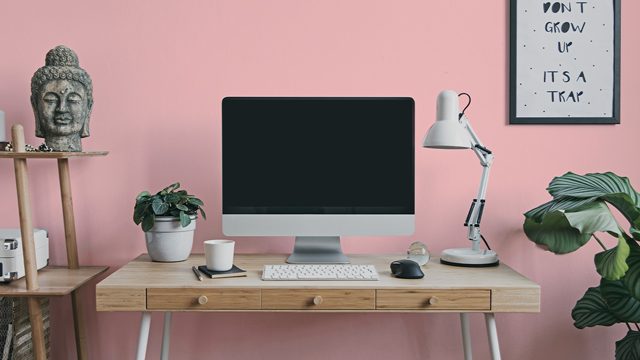SUMMARY
This is AI generated summarization, which may have errors. For context, always refer to the full article.

MANILA, Phillipines – So government declared a Metro-wide lockdown (or what they’re calling a “community quarantine”) and many companies have already implemented flexible or work-from-home schemes for their employees.
However, while most people in the freelancing economy find this setup their everyday reality, some of us coming from more traditional offices may find it hard to adjust to this new setup.
I started working when I was 18, and I’ve been in all setups. I’ve worked for companies with very stringent office processes, where even bringing a pen or paper inside working areas is prohibited. I’ve been in the kind that primarily had only a virtual office, where the work is mainly done online. And I have also managed a small business from home and a boutique coffee shop at one point. Each required a different workspace, given the varied requirements of the job.
In the age of work-life synergy (not just balance), there’s little differentiation between working and living. And the problem with working from home is that it may either make you “work too much and live too little” or “work too little and live too much.”
Here’s how you can function like you’re in an office even when you’re at home.
Set-up a dedicated space
Many people don’t like bringing their work home. I personally have a “no work in bed” policy simply because I’ve had bouts with insomnia, and not working in bed helped me overcome it.
I recently bought a study table just so I can stay inside my room and still have a dedicated space for work. While I still work from our dining table and living room couch from time to time, I’ve realized that having a dedicated workstation at home helps condition you to be in “work mode.”
In my desk, I have my essentials: a case stacked with my essential stationery, a planner/organizer, and my notepad. I usually have these in my bag since we have an open workspace in the office, and I’m generally outside for meetings, so somehow, I have managed to get used to setting my workstation up whenever, wherever.
For those who may have never tried this setup, take note that less is more. Prioritize only the essentials: a sturdy table spacious enough to accommodate your work paraphernalia, a comfortable chair with backrest, and an extension cord neatly laid out for your electronics. The rest can stay in your bag, or you may add to your setup on a need basis.
I personally prefer having my working station against the wall to help me focus and eliminate distractions. I would also recommend staying away from your TV or setting up in a spot where either people move around too much or where noise levels are not conducive to concentration.
Adopt work habits as you would in your office
Work from means more time in bed, yes? No. While it might be harder to pull yourself out of bed knowing that you won’t have to take a bath, prepare what you’ll wear for the day, or plan your commute, it doesn’t mean you should not bother.
One of the things you will have to be mindful of is sticking to a routine.
I usually set my alarm an hour or two before the actual time I have to start working so I can prepare my breakfast, eat, and set my priority list for the day. I’ve also adopted a time-blocking scheme so I can dedicate my time to a specific task, gauge which parts of the day will be heavy, and see when I can take my breaks.
For those with flexible schedules, you may need to recalibrate things depending on your daily workload or the output you have to churn out. While for those with dedicated “man-hours,” it would be best to stick to them.
The struggle with working from home is finding a balance between accountability and autonomy. Most managers will be tempted to micro-manage, and most employees will have to bear the brunt of this.
Luckily, our company provides enough structure to support this and enough freedom to come up with work dynamics that (no other way to put it) work for us as a team and individually.
We check-in via chat at the start of the day and outline our projects. Our managers also send us an outlook of what we should expect and what to prioritize for the day.
Online meetings are followed by debriefs to align and make sure everyone is on the same page, and meeting notes are shared to make sure we keep track of how a project or task is moving.
Project management apps will help do this.
Make your workspace more zen with greenery and lighting
If there’s one thing I’ve learned from my exchange program in Japan way back in college, it’s the importance of making sure that things are in place and they complement your work habits.
Set up your station near a source of daylight. Given that you’ll spend most of your time indoors take in as much sun as possible. If not possible, be as close to a light source or even set up a study lamp. A well-lit workspace will not only light up your area, it will also help you fight sleepiness while you work.
Make sure to also pay attention to ventilation. Studies show that proper airflow allows for better cognitive function. I personally use a humidifier to help improve my room’s air quality and put me in the mood to work.
Adding plants near your station will help improve air quality, plus greenery helps with avoiding eye strain caused by staring for hours at your computer screen – they give you a visual breather.
Keep everything you need within an arm’s reach so you won’t have to move around and lose your focus. Lastly, make sure to Konmari your desk by arranging it according to how you ergonomically would use the things on your table.
Declutter and decompress
When all is set and done, and you’re ready to call it a day, make sure to keep your desk cleared: your stationery packed, your computers closed or turned off, and your files hidden, to tell your brain that it’s time to stop working.
The struggle with working from home is not knowing when to stop. It will be a rough month, and boredom and social isolation will likely be a challenge.
With most establishments being restricted or closed, we will find ourselves with nothing else to do after a long day at work.
When Netflix and social media are no longer enough, read a book or listen to a podcast.
Video call your friends and family members or chat your officemates about non-work related chika, or even your bosses (they’re probably going through the same adjustment as you, or are they).
Chat your significant other if you’re taken, or be more active on dating apps if you’re still searching (but please, social distancing, keep things in the chatroom). These times call for us to be more patient, thoughtful, and creative, both in love and in life.
We all need to take a break from work and have a semblance of normalcy amid this chaos. As they say, it will get worse before it gets better, but it’s essential to keep things in perspective, still do an excellent job at work, and not let this lockdown get the best of us and our humanity. – Rappler.com

Russel is your everyday millennial with almost a decade of work experience spanning BPO, NGO, Digital Marketing, and Journalism. He’s currently a brand strategist for data forensics and business strategy company, TheNerve.co.
Read more Hustle stories:
- #HustleEveryday: What apps do offices need for an efficient work-from-home system?
- LIST: Grocery delivery options in Metro Manila
- Keep calm and cope: How to stay mentally healthy during coronavirus crisis
- Yes you can! Work out at home with these YouTube channels and apps
- Doorstep delivery: Order fresh fruits and veggies online through these 5 shops
Add a comment
How does this make you feel?


There are no comments yet. Add your comment to start the conversation.